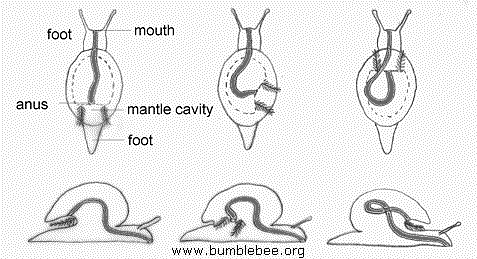
Adaptation
Daedalochila uvulifera is a larger snail compared to
other species of Daedalochila. They are on average
about 11mm (Daedalochila, 2008). Being a larger snail has it's
benefits and down falls as well. Being a bigger snail, food
can be easily obtained but predators can easily spot the snail.
Daedalochila uvulifera uses a foot like most other gastropods to
move. Daedalochila uvulifera's foot is a solelike structure
that allows for a creeping motion through waves of muscle
contractions (Hickman et al, 2009). The foot secretes a mucus,
aiding in locomotion. This mucus that is secreted reduces
friction and aids in adhesion (Hickman et al, 2009).
Torsion is where the visceral mass, mantle, and shell turn 180°,
the mantle cavity and anus come to a posterior position above the
head (Bumblebee, 2012). This is considered a two step process, the foot
muscle contracts and pulls the shell and enclosed visceral mass 90°
counterclockwise (Hickman et al, 2009). After this movement,
the anus and mantle cavity move farther right, the mantle is
reconfigured to house the anus, the anus then lies dorsal to the
head within in the mantle cavity (Hickman et al, 2009). With
torsion, fouling becomes a problem with terrestrial land snails like
Daedalochila uvulifera. Fouling is when waste that is excreted,
washes back into the snails gills.

To combat fouling, gastropods undergo coiling, this process can
occur at the same time as torsion (Hickman et al, 2009).
Coiling is what give the shell its trademark swirl. With the
shell coiling and pressed on the right side of the mantle cavity,
over the years gastropods have lost the gill, auricle and kidney
(Hickman et al, 2009). With the
loss of the right gill, fouling is less likely to happen.
Snails excrete waste down stream or wind, the flow of water hits the left side of the
snail, then the waste is carried from the anus to the nephridiopore,
which is on the right side of the snail
(Hickman et al, 2009).
Their shell is very unique compared to other snails. Their
whorl on the shell is dorsal compared to being on the right side.
The average size of the shell for Daedalochila uvulifera has about
5½-6½ whorls, equaling about 11-16.4 mm wide (Pilsbry
[2],
1939). The whorls are also flattened, they don't protrude out,
not much is known why but speculation is that it allows the snail to maintain a low center of gravity and
better balance (Hickman et al, 2009).
Another guess would be that it allows for easier hiding among the
leaf litter or grass from predators. The shell is usually semi
glossy, nearly smooth, with the last whorl are some coarse striae (Pilsbry
[1], 1939).